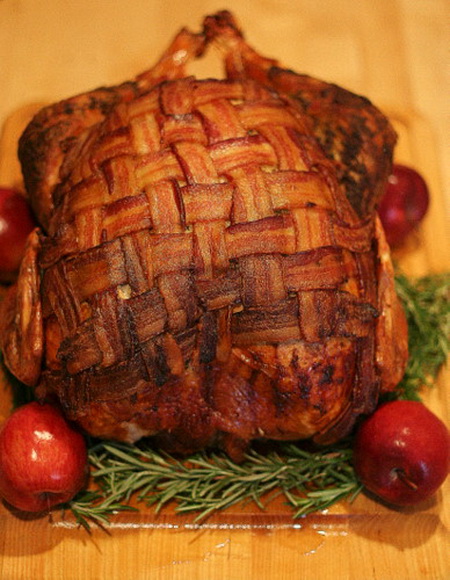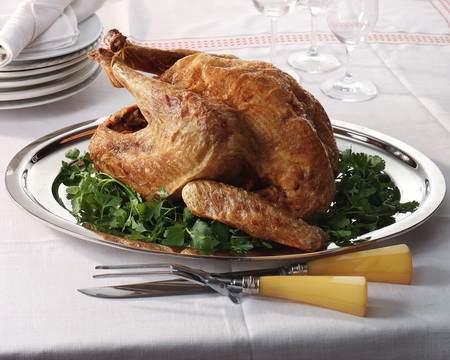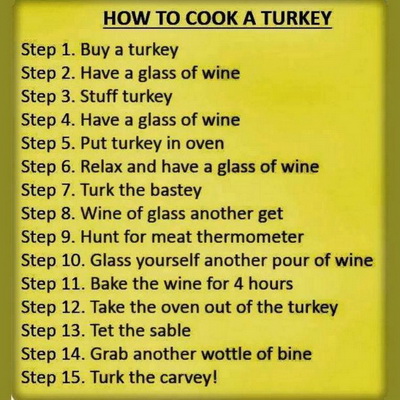You may have some wines in mind for your Thanksgiving roast turkey, but what should you drink with non-traditional recipes, like turducken or deep-fried turkey?
That’s what Lindsey and I chat about on CTV’s Your Morning, the country’s national breakfast show.
Let’s start with beer can turkey. What is it and which wines should we have with this dish?
So for this wonderfully weird recipe, you sit the turkey on a beer can on a grill, which results in a moist meat, and a crispy, satin-brown skin. Of course, you could pair this dish with beer since you cooked with it.
However, when a dish pairs well with beer, it’ll also work with sparkling wine like this Catherine Cuvee Rose from Henry of Pelham in Niagara. The froth and bubbles of the wine are a great complement to the bird and moisten it further.
Henry of Pelham Cuvee Catharine Rosé Brut
Niagara Escarpment, Ontario V.Q.A., Canada
Alternatively, you could go with a juicy, cherry-berry Pinot Noir like this one from California called Mirassou. The bonus that it’ll also pair well with your side dishes like cranberry sauce.
Mirassou Winery Pinot Noir
California, United States
Okay, let’s move on to turducken.
Turducken is a three-in-one bird: It’s a turkey stuffed with a duck, which, in turn, is stuffed with a chicken and all three are deboned, then roasted.
The gamey flavours of the duck in this dish guides my wine pairings: a full-bodied red wine, like this Annaberta Sa’Solin Valpolicella from Italy would be great with the duck and the gravy.
Villa Annaberta Wines Valpolicella Ripasso Superiore
Veneto DOC, Italy
If you prefer white wines though, go with a zesty, mouth-watering white like this l’Acadie Blanc from Domaine de Grand Pre in Nova Scotia. It’ll make your mouth water — just what we want when it comes to turkey, which can be a drier meat.
Domaine de Grand Pré Vintner’s Reserve l’Acadie Blanc
Grand Pre, Nova Scotia, Canada
How about deep-fried turkey?
The turkey is marinated then fried in oil in a turkey frier, usually outside on the back deck. That’s why I often pair this one with a fire extinguisher in addition to wine.
Frying makes many dishes delicious with that crackling skin and moist, fall-apart meat. I think of wine that would pair well with French fries or fried chicken, like this lovely crisp Riesling from Trius winery in Niagara on the Lake. The racy acidity cuts through the fat of the frying making each bite even more tasty. This is also a great wine with your green beans and brussels sprouts.
Trius Dry Riesling
Four Mile Creek, Niagara-on-the-Lake, Ontario V.Q.A., Canada
Red wine lovers can try this Malbec from Toro in Argentina. It’s smooth, luscious and full-bodied, like the turkey. Its dark berry flavours are perfect for the stuffing too.
Bodega Toro Winery Centenario Malbec
Mendoza, Argentina
And finally, we have a bacon-wrapped turkey.
Bacon makes the world a good place, and I love it with anything, but especially when thick slices of it are lovingly wrapped around turkey before roasting. It gives the bird a rich, smoky flavour.
For this pairing, we’re going out to British Columbia with this Sauvignon Blanc from Winemaker’s Cut which has a bright contrasting note to the bacon. This wine would also be a zesty counterpoint to your mashed potatoes and creamed corn.
Winemaker’s CUT Sauvignon Blanc
Okanagan Valley, British Columbia BC V.Q.A., Canada
This California Cabernet from Stave & Steel that’s aged in Canadian Whiskey Barrels is also a great choice because it’s smooth without those furry-mouth tannins you get when you eat walnuts. Plus, it has a toffee finish from the barrels so it can also pair beautifully with your pumpkin spice pie.
Stave & Steel Canadian Whisky Barrel Cabernet Sauvignon
California, United States
Would any of these wines pair with traditional roast turkey?
They’d all work well, but if I had to pick just a few, I’d start with a toast of the Catharine Cuvee sparkling, then I’d pour the Trius Riesling with the turkey and sides, and slip into the Stave & Steel Cab as the meal progressed and we move into dessert.
 Bacon-Blanketed, Herb Roasted Turkey Recipe
Bacon-Blanketed, Herb Roasted Turkey Recipe
This is the turkey. I’ve been perfecting this for many years now. I must say, it is a showstopper, and delicious to boot, because I treat it well. I send my turkey to a bacon spa. It gets a salt scrub, a bacon butter deep tissue massage, a hand-woven bacon spa robe, some time in the sauna and a little tanning to finish it off.
I’ve got a set of instructions here, more than a recipe, but this way there is enough detail to produce a beautiful bird.

I usually cook an 18 – 20 pound turkey. Not because I have a huge family, but because I like Thanksgiving leftovers. I always buy a fresh, never frozen turkey of the best quality I can afford. If you buy a frozen turkey, you need to get it in advance and leave plenty of time for thawing. You can do a computer search for the proper method. My methods below are for a big bird, but easily adapt to a smaller one.
What you’ll need:
A large plastic bag
A platter or pan that fits the turkey in the fridge
Kitchen twine
A roasting pan that fits the turkey (and fits in your oven. Check. This is important.)
A probe-style meat thermometer
A turkey
Lots of kosher salt
1½ pounds bacon
½ pound butter
Fresh herbs: sage, thyme, oregano, parsley, marjoram, rosemary
Roasting vegetables: carrots, celery, onions, leeks, apples
I dry brine my turkey for a juicy bird. I used to wet brine, which involved removing drawers from my fridge and stuffing turkey into a large stockpot full of salted water. That is a lot of trouble. Here’s my easy solution that makes for a lovely moist turkey.
Start the brine 2 to 3 days before Thanksgiving. Remove all the interior parts from the bird. Discard them or use them for stock, or the giblets for gravy. Wash the bird well, inside and out. Place the bird in a great big plastic bag. Cookware stores sell fancy “brining bags” but a cheap browning bag from the grocery works just as well, or a big ziptop bag.
Go to town rubbing kosher salt all over the gobbler, inside and out. Use a lot of salt. Wash your hands. Tie the bag closed and place it on a platter or pan and put it in the fridge for up to two days. I do this on Tuesday, butter it up on Wednesday for cooking on Thursday. Thoroughly wash the sink you rinsed the turkey in. Right now.
Now we work on the flavor and added juiciness. I tinkered with this recipe for many years, until I hit on just the right method. I have always rubbed butter on roasted chicken or turkey, or covered it in bacon to keep the bird moist. For a big mama gobbler, I double down.
In a food processor, blend together ½ pound raw bacon slices, ½ pound butter and generous handfuls of fresh herbs. I like a lot of sage, some parsley, oregano, thyme, marjoram and maybe rosemary. A packet and a half of “poultry herbs” works well. Blend all this until you have a smooth paste. You can make this ahead and store the bacon butter in an airtight container for up to five days.
We eat our big meal at one o’clock, so I like to have everything ready to go in the morning. I prepare my bird on Wednesday evening and refrigerate it. I have a timer feature on my oven that lets me start preheating before I want to wake up, so the oven is ready for the bird when I stumble out of bed.
When you are ready to prepare the turkey, bring the bacon butter to room temperature. Take the turkey out of its salt bag and give it a good rinse. Place it breast side up on a large platter or pan that will fit in the fridge. Wash the sink you rinsed the turkey in. Now.
If your turkey comes with a pop-up timer, remove it now. It’s useless.
Wash your hands, remove your rings and watch and gently separate the skin from the flesh. Lift the skin by the cavity and gently slide your hands under the skin. It will pull away from the flesh. Keep going to get the skin opened up all the way to the neck and over the legs. Try not to tear the skin, but don’t fall apart if you do. It’s not a big deal.
Now take big fistfuls of butter and rub it up under the skin and over the flesh. Use about ¾ quarters of the bacon butter under the flesh. Pat the skin down and press the butter into a pretty even layer under the skin. Rub the remaining butter over the outside of the bird, paying particular attention to the legs, which will not be covered by the bacon blanket.
There is nothing like presenting a beautiful bird to your guests at Thanksgiving, and if I may say so, this is a stunner. But the bacon is not only decorative, it amps up the juiciness of the meat and flavors the juices for the gravy. I use thick cut bacon, the best I can find. I don’t use any kind of artificially flavored bacon. My big babies use about a pound of bacon.
I think the picture really says it all. I weave the bacon strips into a lattice. It’s kind of like making those construction paper place mats from kindergarten. Lay one strip crosswise over the breast, then one lengthwise. Keep going, folding up the strips already placed to fit the new ones under.
The bacon will shrink when you cook the bird, so place the strips close together and use as many as you can fit.
Tie the legs of the bird together with kitchen twine.
When you’ve got the bacon all woven, wash your hands thoroughly, put the bird in the fridge, fix yourself a bourbon and collapse on the sofa.
As I said, we do the meal for lunch, and I am not a morning person, so I do as much ahead as possible. With the turkey ready to go and the oven heated to 450 degrees, I get ready to roast.
Remember, remove one rack and place the other in the right position to fit the pan with the bird. You don’t want to get everything hot, then have to move things around.
I like good, flavorful juices from the bird to add to gravy. That really is the only thing that makes gravy worth serving. My roasting technique creates good juices.
Line the deep roasting pan that fits your bird with several layers of foil. It never makes clean up a breeze, but it helps.
If you have a rack that fits a deep roasting pan, great. I use a grid that is technically a cooling rack. No rack, no problem.
Just set the bird on the vegetables as follows. Cover the bottom of the roasting dish with a thick layer of aromatic root vegetables. Whole vegetables, don’t’ peel or chop, just remove the paper from onions and the tops from carrots. I use carrots, celery, leeks, onions and a couple of apples cut in half.
Stuff an apple and an onion into the cavity of the bird. Tuck some fresh sage leaves and any other herbs you have around the bird.
Place the rack over the vegetables if you are using one, don’t worry if it’s wobbly, or just put the bird on the vegetables directly.
Take a piece of foil and mold it to make a shield to cover the bird if it starts to brown too much later.
Remove the molded piece of foil to a safe place. It is really hard to properly cover a hot turkey in a hot oven.
Roast the turkey at 450° for 30 minutes, then turn the heat down to 375° for the rest of the cooking.
I highly recommend that you make the small investment in a probe meat thermometer, one with a probe to stick in the turkey and a long cord that plugs into a counter unit. Gently stick the probe into a thick part of the breast, carefully sliding it between an opening in the bacon blanket. Make sure you don’t’ go so deep you hit the bone. You want the turkey to be cooked to 165°.
I usually set the thermometer to 155°, remove the turkey from the oven and cover the whole pan with foil. I let it rest until it reaches 165°.
If the turkey and the bacon start to get too brown before the meat is cooked, cover it with your prepared foil armor. Generally, you need about 15 minutes cooking per pound of turkey. For a 20 pound turkey, I go 4 to 4 ½ hours. Leave your self some wiggle room, the turkey will happily wait under its warm foil wrap. Your guests are not likely to be so patient.
Now we have our beautiful cooked turkey.
Remove the bird to carving board (preferably one with a well to collect juices). Allow some time for your guests to ohh and ahh and admire your bird. Then let the designated carver go to work.
Pour the juices from the roasting pan into a measuring cup, or one of those neat gravy separators if you have one. Let the juice settle for a bit, skim off the fat, and add the delicious juices to your gravy.
– See more at: The Runaway Spoon
 Cajun Deep-Fried Turkey Recipe
Cajun Deep-Fried Turkey Recipe
Cajun Deep-Fried Turkey
1/3 cup kosher salt
3 tablespoons onion powder
3 tablespoons black pepper
3 tablespoons white pepper
2 tablespoons sweet basil
2 teaspoons bay leaves, ground
1 tablespoon cayenne pepper
2 teaspoons filé powder
3 tablespoons garlic powder
1½ tablespoons paprika
WHOLE TURKEY, non self-basting: 1 10-12 Pound
peanut oil, See Note: 4 to 5 Gallons
Stir salt, herbs and peppers together. Mix until well blended. Use 1/2 to 2/3 cup for a 10-12 pound turkey. May be stored for several months in an airtight covered jar.
Remove the giblets and neck, rinse the turkey well with cold water and pat dry thoroughly with paper towels. Take care to dry both inside cavities.
Place in a large pan and rub the interior and exterior of the bird with seasoning mix.
To allow for good oil circulation through the cavity, do not truss or tie legs together. Cut off the wing tips and plump little tail as they may get caught in the fryer basket.
Cover pan and place in refrigerator overnight.
Place the OUTDOOR gas burner on a level dirt or grassy area. Never fry a turkey indoors, in a garage or in any structure attached to a building. Do not fry on wood decks, which could catch fire, or concrete, which could be stained by the oil. (Safety tip: have a fire extinguisher nearby for added safety.)
Add oil to a 7-10 gallon pot with a basket or rack. At the medium-high setting, heat the oil to 375 degrees F., (depending on the amount of oil, outside temperature and wind conditions, this should take about 40+ minutes).
Meanwhile, place the turkey in a basket or on a rack, neck down.
When the oil temperature registers 375 degrees F on a deep-fry thermometer, slowly lower the turkey into the hot oil. The level of the oil will rise due to the frothing caused by the moisture from the turkey but will stabilize in about one minute. (Safety tips: to prevent burns from the splattering oil wear oven mitts/gloves, long sleeves, heavy shoes and even glasses. It is wise to have two people lowering and raising the turkey.)
Immediately check the oil temperature and increase the flame so the oil temperature is maintained at 350 degrees F. If the temperature drops to 340 degrees F. or below, oil will begin to seep into the turkey.
Fry about 3-4 minutes per pound, or about 35-42 minutes for a 10-12 pound turkey. Stay with the cooker at all times as the heat must be regulated.
When cooked to 165 degrees F. in the breast or 175 degrees F. in the thigh, carefully remove the turkey from the hot oil. Allow the turkey to drain for a few minutes. (Safety tip: allow the oil to cool completely before storing or disposing.)
Remove turkey from the rack and place on a serving platter. Allow to rest for 20 minutes before carving.
NOTE: Use only oils with high smoke points, such as peanut, canola or safflower oil. To determine the correct amount of oil, place the turkey in the pot before adding seasoning and add water until turkey is covered. Take turkey out of the water before marking the oil level. Measure the amount of water and use a corresponding amount of oil. Dry the pot thoroughly of all water.
Nutritional analysis is based on a 5.9 ounce serving.
Recipe and Photos Provided by the National Turkey Federation
Posted with permission of CTV.
















